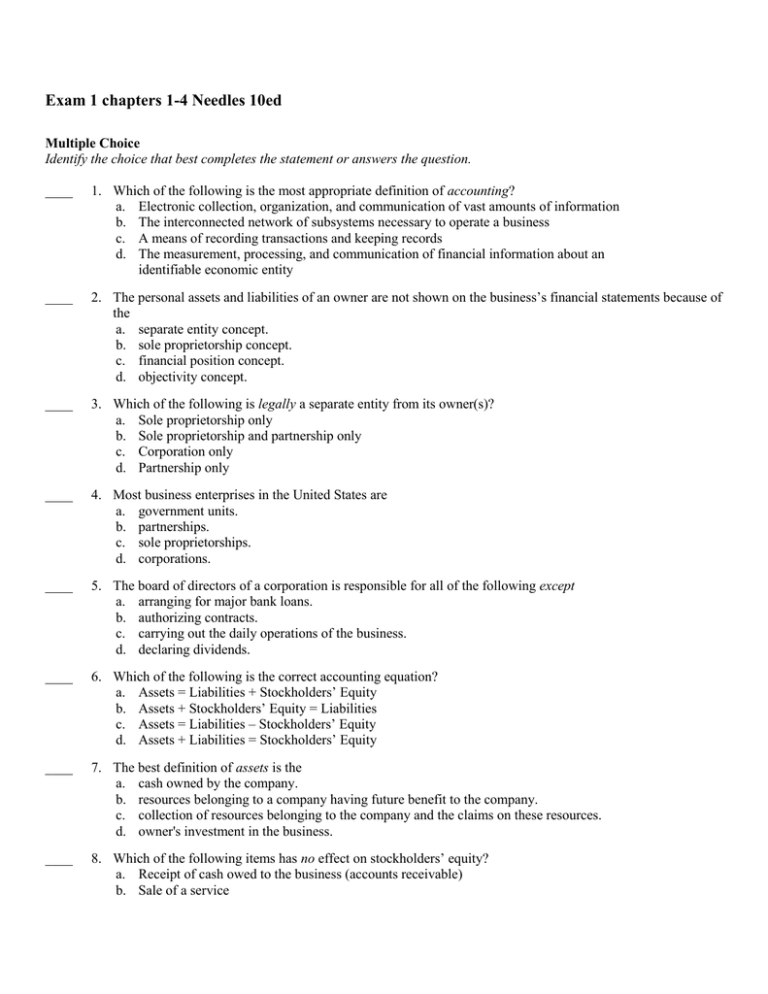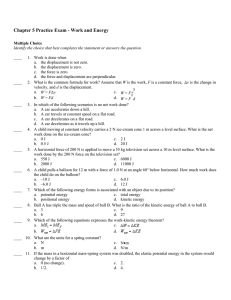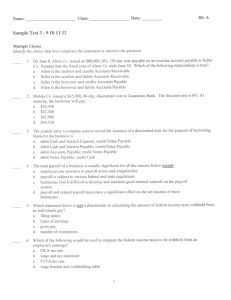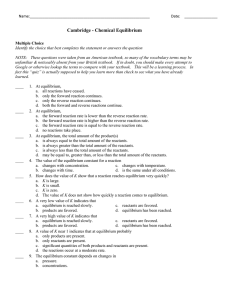Exam 1 chapters 1
Anuncio

Exam 1 chapters 1-4 Needles 10ed Multiple Choice Identify the choice that best completes the statement or answers the question. ____ 1. Which of the following is the most appropriate definition of accounting? a. Electronic collection, organization, and communication of vast amounts of information b. The interconnected network of subsystems necessary to operate a business c. A means of recording transactions and keeping records d. The measurement, processing, and communication of financial information about an identifiable economic entity ____ 2. The personal assets and liabilities of an owner are not shown on the business’s financial statements because of the a. separate entity concept. b. sole proprietorship concept. c. financial position concept. d. objectivity concept. ____ 3. Which of the following is legally a separate entity from its owner(s)? a. Sole proprietorship only b. Sole proprietorship and partnership only c. Corporation only d. Partnership only ____ 4. Most business enterprises in the United States are a. government units. b. partnerships. c. sole proprietorships. d. corporations. ____ 5. The board of directors of a corporation is responsible for all of the following except a. arranging for major bank loans. b. authorizing contracts. c. carrying out the daily operations of the business. d. declaring dividends. ____ 6. Which of the following is the correct accounting equation? a. Assets = Liabilities + Stockholders’ Equity b. Assets + Stockholders’ Equity = Liabilities c. Assets = Liabilities – Stockholders’ Equity d. Assets + Liabilities = Stockholders’ Equity ____ 7. The best definition of assets is the a. cash owned by the company. b. resources belonging to a company having future benefit to the company. c. collection of resources belonging to the company and the claims on these resources. d. owner's investment in the business. ____ 8. Which of the following items has no effect on stockholders’ equity? a. Receipt of cash owed to the business (accounts receivable) b. Sale of a service c. Payment of an expense d. Dividend distributions ____ 9. Which of the following accounts is not considered an asset? a. Accounts Receivable b. Inventory c. Accounts Payable d. Trademark ____ 10. Sinoyianis Realty Company had the following balance sheet accounts and balances: Accounts Payable Accounts Receivable Building Cash $12,000 2,000 16,000 6,000 Common Stock Equipment Land Retained Earnings $10,000 14,000 14,000 ? What is the balance of the Retained Earnings account? a. $8,000 b. $12,000 c. $28,000 d. $30,000 ____ 11. Sinoyianis Realty Company had the following balance sheet accounts and balances: Accounts Payable Accounts Receivable Building Cash $12,000 2,000 16,000 6,000 Common Stock Equipment Land Retained Earnings $ 10,000 14,000 14,000 30,000 If $6,000 of Accounts Payable were paid in cash, what would be the total of liabilities and stockholders’ equity? a. $28,000 b. $34,000 c. $46,000 d. $52,000 ____ 12. Use this information to answer the following question. Here is the balance sheet for Costello Container Company: Assets Cash Accounts receivable Land Building Equipment Total assets Costello Container Company Balance Sheet December 31, 2014 Liabilities $ 8,000 Accounts payable 3,000 14,000 Stockholders’ Equity 44,000 Common stock 13,000 Retained earnings Total liabilities and $82,000 stockholders’ equity $16,000 20,000 46,000 $82,000 If the balance in the Cash account were used to buy more equipment, then the total assets would a. remain unchanged. b. increase by $8,000. c. decrease by $8,000. d. increase by $21,000. ____ 13. The Public Company Accounting Oversight Board was created by the a. Sarbanes-Oxley Act. b. GASB. c. IRS. d. IASB. ____ 14. The purpose of an audit is to a. determine whether or not a company is a good investment. b. comply with income tax regulations. c. determine whether or not a company is a good credit risk. d. ascertain that the financial statements follow GAAP. ____ 15. The issue of deciding when to record a transaction is solved by a. properly classifying the transaction. b. deciding on a point of recognition. c. assigning historical cost to the transaction. d. analyzing the intent of management. ____ 16. Which of the following accounts is increased with a credit? a. Office Supplies b. Unearned Revenue c. Land d. Prepaid Insurance ____ 17. The double-entry system a. requires that each transaction be recorded with at least one debit and one credit. b. requires that the total amount of the debits must always equal the total amount of the credits. c. is based on the principle of duality. d. All of these choices. ____ 18. Which of the following does not impact the Statement of Retained Earnings? a. Common Stock b. Revenues c. Expenses d. Dividends ____ 19. The declaration of dividends will a. decrease net income. b. increase liabilities. c. not affect total assets. d. increase stockholders’ equity. ____ 20. Receiving cash from a customer for settlement of an Accounts Receivable will a. decrease Stockholders’ Equity. b. increase net income. c. increase total assets. d. not affect total assets. ____ 21. When a service has been performed, but no cash has been received, which of the following statements is true? a. The entry would include a debit to Accounts Receivable. b. The entry would include a debit to Accounts Payable. c. The entry would include a credit to Unearned Revenue. d. No entry is required until the cash is received. ____ 22. The controller for Tires and More, Inc. has recorded the following transactions during the month: the purchase of equipment for $8,500 cash; payment of $6,300 for 3 months of rent; and, collection of $2,400 from a customer for services performed. At the beginning of the month the company was established by selling 10,000 shares of stock to the public for $15,000 cash. What is the balance in the Cash account at the end of the month, and is the balance a debit or a credit? a. $2,600 debit. b. $2,600 credit. c. $6,800 debit. d. $15,200 debit. ____ 23. The trial balance for Parker Company is as follows: Parker Company Trial Balance January 31, 20x5 Cash $ 6,000 Accounts Receivable 4,000 Art Supplies 6,000 Office Supplies 10,000 Prepaid Rent 14,000 Prepaid Insurance 10,000 Art Equipment 10,000 Office Equipment 6,000 Accounts Payable Common Stock Dividends ? Advertising Fees Earned Wages Expense ? Utilities Expense 10,000 Telephone Expense 6,000 $ A $ 10,000 30,000 ? ________ $ B If the balance of the Dividends account were $100,000 and the balance of the Wages Expense account were $10,000, what would be the amount of B? a. $124,000 b. $150,000 c. $192,000 d. $152,000 ____ 24. The primary purpose of the trial balance is to test the a. recording of transactions. b. analysis of transactions. c. equality of debit and credit balances in the ledger. d. equality of debit and credit balances in the journal. ____ 25. Which of the following errors will cause the trial balance to be out of balance? a. An entire transaction was entered in the general journal as $27 instead of $72. b. An entire transaction was omitted from the general journal. c. The balance of an account was incorrectly computed. d. A debit entry was entered in the wrong debit account. ____ 26. Which of the following accounts might be placed first in a journal entry? a. Interest Payable, when it has been decreased. b. Accounts Receivable, when it has been decreased. c. Unearned Revenue, when it has been increased. d. Service Revenue, when it has been increased. ____ 27. The process of transferring journal entry information from the journal to the ledger is called a. journalizing. b. posting. c. footing. d. analyzing. ____ 28. A purchase is recognized in the accounting records when a. payment is made for the item purchased. b. the purchase requisition is sent to the purchasing department. c. title transfers from the seller to the buyer. d. the buyer receives the seller's bill. ____ 29. When a credit sale takes place, a. a revenue account will increase. b. liabilities will increase. c. one asset account will increase and another will decrease. d. assets will be unaffected. ____ 30. Which of the following transactions does not result in an increase in expenses? a. Payment of accounts payable. b. Usage of utilities. c. Allocation of the cost of a building. d. Expiration of prepaid insurance. ____ 31. Financial statement time periods should be of equal length a. and should end during the peak season. b. to make comparison easier. c. and should correspond to the calendar year. d. to comply with income tax regulations. ____ 32. Equipment might be depreciated over 15 years because a. it will lose most of its market value in 15 years. b. it will be paid for in 15 years. c. it will help to generate revenue for the company over 15 years. d. income tax provisions require depreciation over 15 years. ____ 33. Which of the following is correct regarding accrual accounting? a. Adjusting the accounts is a technique used to accomplish accrual accounting. b. Revenues are recorded when received. c. Expenses are recorded when earned. d. Net income is the difference between cash receipts from customers and cash payments for expenses. ____ 34. Which of the following accounts would not need to be adjusted at year end? a. Prepaid Rent. b. Common Stock. c. Equipment. d. Unearned Rent Revenue. ____ 35. An adjusting entry made to record salaries earned but not yet paid or recorded is made with which of the following entries? a. Salaries Expense – Debit; Cash – Credit b. Salaries Payable – Debit; Salaries Expense – Credit c. Salaries Expense – Debit; Salaries Payable – Credit d. Cash – Debit; Salaries Expense – Credit ____ 36. Which of the following accounts is a contra account? a. Accumulated Depreciation–Office Furniture b. Interest Payable c. Depreciation Expense–Office Furniture d. Unearned Revenue ____ 37. Failure to adjust for expired prepaid insurance at year end will result in an a. overstatement of liabilities. b. understatement of assets. c. understatement of stockholders' equity. d. overstatement of net income. ____ 38. Use this information to answer the following question. The trial balance for Nowwick Company appears as follows: Nowwick Company Trial Balance December 31, 20x5 Cash Accounts Receivable Prepaid Insurance Supplies Office Equipment Accumulated Depreciation–Office Equipment Accounts Payable Common Stock Service Revenue Salaries Expense Rent Expense $ 240 1,000 100 300 800 $ 400 600 1,200 1,000 200 400 $3,200 ______ $3,200 If on December 31, 20x5, supplies on hand were $120, the adjusting entry would contain a a. credit to Supplies for $120. b. credit to Supplies Expense for $180. c. debit to Supplies Expense for $180. d. debit to Supplies for $120. ____ 39. Use this information to answer the following question. The trial balance for Nowwick Company appears as follows: Nowwick Company Trial Balance December 31, 20x5 Cash Accounts Receivable Prepaid Insurance Supplies Office Equipment Accumulated Depreciation–Office Equipment Accounts Payable Common Stock Service Revenue Salaries Expense Rent Expense $ 240 1,000 100 300 800 $ 400 600 1,200 1,000 200 400 $3,200 ______ $3,200 If on December 31, 20x5, the insurance still unexpired amounted to $20, the adjusting entry would contain a a. debit to Prepaid Insurance for $80. b. credit to Prepaid Insurance for $80 c. debit to Insurance Expense for $20. d. credit to Prepaid Insurance for $20. ____ 40. Accounting information should make a difference to the outcome of a decision, according to the qualitative characteristic of a. faithful representation. b. relevance. c. consistency. d. understandability. ____ 41. The Securities and Exchange Commission instituted rules requiring the chief executive officers and chief financial officers of all publicly traded companies to certify that, to their knowledge, the quarterly and annual statements that their companies file with the SEC are a. 100 percent accurate and contain no misstatements, errors, or mistakes. b. accurate and complete. c. subject to interpretation due to the many accounting rules and regulations. d. not to be used except by individuals working for the company. ____ 42. Which of the following accounting conventions would an accountant most likely apply when facing major uncertainties? a. Understandability b. Conservatism c. Materiality d. Verifiability ____ 43. A company should classify land held for a planned manufacturing facility as a. an intangible asset. b. an investment. c. a current asset. d. property, plant, and equipment. ____ 44. Which of the following should be classified as an intangible asset? a. Land held for future use b. Long-term notes receivable c. Special funds established to pay off a debt d. Copyright ____ 45. Use this information to answer the following question. Sunshine Travel Balance Sheet December 31, 20x5 Assets Cash Short-term investments Notes receivable (due in ten months) Accounts receivable Merchandise inventory Land held for future use Land Building Less accumulated depreciation Trademark Total assets $ 40,000 20,000 15,000 10,000 35,000 40,000 45,000 $50,000 10,000 40,000 35,000 $280,000 Liabilities Notes payable (due in six months) Accounts payable Salaries payable Mortgage payable (due in seven years) Total liabilities Stockholders' Equity Common Stock Retained Earnings Total Stockholders’ Equity Total liabilities and stockholders’ equity The total dollar amount of assets to be classified as current assets is a. $105,000. b. $145,000. c. $95,000. d. $120,000. $ 25,000 10,000 5,000 45,000 $85,000 100,000 95,000 195,000 $280,000 ____ 46. Use this information to answer the following question. Sunshine Travel Balance Sheet December 31, 20x5 Assets Cash Short-term investments Notes receivable (due in ten months) Accounts receivable Merchandise inventory Land held for future use Land Building Less accumulated depreciation Trademark Total assets $ 40,000 20,000 15,000 10,000 35,000 40,000 45,000 $50,000 10,000 40,000 35,000 $280,000 Liabilities Notes payable (due in six months) Accounts payable Salaries payable Mortgage payable (due in seven years) Total liabilities Stockholders' Equity Common Stock Retained Earnings Total Stockholders’ Equity Total liabilities and stockholders’ equity $ 25,000 10,000 5,000 45,000 $85,000 100,000 95,000 195,000 $280,000 The total dollar amount of assets to be classified as property, plant, and equipment is a. $135,000. b. $125,000. c. $95,000. d. $85,000. ____ 47. Which of the following accounts is most likely to appear on the balance sheet as a current liability? a. Accumulated Depreciation b. Bonds Payable c. Mortgage Payable d. Wages Payable ____ 48. Goodwill would appear in which balance sheet section? a. Investments b. Property, plant, and equipment c. Current assets d. Intangible assets ____ 49. Use this balance sheet and income statement to answer the following question. Use ending balances whenever average balances are required for computing ratios. National Textile Balance Sheet December 31, 20x5 Assets Current assets Investments Property, plant, and equipment Intangible assets Total assets $ 12,000 2,000 16,000 10,000 $40,000 Liabilities Current liabilities Long-term liabilities Total liabilities Stockholders' Equity Common stock Total liabilities and stockholders' equity $ 8,000 2,000 $ 10,000 30,000 $40,000 National Textile Income Statement For the Year Ended December 31, 20x5 Net sales Cost of goods sold Gross margin Operating expenses Net income $48,000 16,000 $32,000 22,400 $ 9,600 The total amount of working capital for National Textile is a. $2,000. b. $6,000. c. $4,000. d. $30,000. ____ 50. Use this balance sheet and income statement to answer the following question. Use ending balances whenever average balances are required for computing ratios. National Textile Balance Sheet December 31, 20x5 Assets Current assets Investments Property, plant, and equipment Intangible assets Total assets $ 12,000 2,000 16,000 10,000 $40,000 Liabilities Current liabilities Long-term liabilities Total liabilities Stockholders' Equity Common stock Total liabilities and stockholders' equity $ 8,000 2,000 $ 10,000 30,000 $40,000 National Textile Income Statement For the Year Ended December 31, 20x5 Net sales Cost of goods sold Gross margin Operating expenses Net income The current ratio for National Textile is a. 1.20. b. 1.75. c. .67. d. 1.50. $48,000 16,000 $32,000 22,400 $ 9,600 Exam 1 chapters 1-4 Needles 10ed Answer Section MULTIPLE CHOICE 1. ANS: OBJ: STA: 2. ANS: OBJ: STA: 3. ANS: OBJ: STA: KEY: 4. ANS: OBJ: STA: KEY: 5. ANS: OBJ: STA: KEY: 6. ANS: OBJ: STA: 7. ANS: OBJ: STA: 8. ANS: OBJ: STA: 9. ANS: OBJ: STA: 10. ANS: OBJ: STA: 11. ANS: OBJ: STA: 12. ANS: OBJ: STA: KEY: 13. ANS: OBJ: STA: 14. ANS: D PTS: 1 DIF: Difficulty: Easy LO: 01-01 NAT: BUSPROG: Reflective Thinking AICPA: FN-Measurement | ACBSP: APC-02-GAAP KEY: Bloom's: Knowledge A PTS: 1 DIF: Difficulty: Easy LO: 01-01 NAT: BUSPROG: Reflective Thinking AICPA: FN-Measurement | ACBSP: APC-02-GAAP KEY: Bloom's: Knowledge C PTS: 1 DIF: Difficulty: Easy LO: 01-01 NAT: BUSPROG: Reflective Thinking AICPA: FN-Measurement | ACBSP: APC-03-Business Forms Bloom's: Knowledge C PTS: 1 DIF: Difficulty: Easy LO: 01-01 NAT: BUSPROG: Reflective Thinking AICPA: FN-Measurement | ACBSP: APC-03-Business Forms Bloom's: Knowledge C PTS: 1 DIF: Difficulty: Easy LO: 01-01 NAT: BUSPROG: Reflective Thinking AICPA: FN-Measurement | ACBSP: APC-03-Business Forms Bloom's: Knowledge A PTS: 1 DIF: Difficulty: Easy LO: 01-02 NAT: BUSPROG: Reflective Thinking AICPA: FN-Measurement | ACBSP: APC-02-GAAP KEY: Bloom's: Knowledge B PTS: 1 DIF: Difficulty: Easy LO: 01-02 NAT: BUSPROG: Reflective Thinking AICPA: FN-Measurement | ACBSP: APC-02-GAAP KEY: Bloom's: Knowledge A PTS: 1 DIF: Difficulty: Moderate LO: 01-02 NAT: BUSPROG: Reflective Thinking AICPA: FN-Measurement | ACBSP: APC-02-GAAP KEY: Bloom's: Comprehension C PTS: 1 DIF: Difficulty: Easy LO: 01-02 NAT: BUSPROG: Reflective Thinking AICPA: FN-Measurement | ACBSP: APC-02-GAAP KEY: Bloom's: Comprehension D PTS: 1 DIF: Difficulty: Moderate LO: 01-02 NAT: BUSPROG: Analytic AICPA: FN-Measurement | ACBSP: APC-02-GAAP KEY: Bloom's: Analysis C PTS: 1 DIF: Difficulty: Moderate LO: 01-02 NAT: BUSPROG: Analytic AICPA: FN-Measurement | ACBSP: APC-02-GAAP KEY: Bloom's: Analysis A PTS: 1 DIF: Difficulty: Moderate LO: 01-02 | LO: 01-03 NAT: BUSPROG: Measurement AICPA: FN-Reporting | ACBSP: APC-09-Financial Statements Bloom's: Analysis A PTS: 1 DIF: Difficulty: Easy LO: 01-04 NAT: BUSPROG: Ethics AICPA: BB-Legal | ACBSP: APC-02-GAAP KEY: Bloom's: Knowledge D PTS: 1 DIF: Difficulty: Easy 15. 16. 17. 18. 19. 20. 21. 22. 23. 24. 25. 26. OBJ: STA: ANS: OBJ: STA: KEY: ANS: OBJ: STA: KEY: ANS: OBJ: STA: KEY: ANS: OBJ: STA: KEY: ANS: OBJ: STA: KEY: ANS: OBJ: STA: KEY: ANS: OBJ: STA: KEY: ANS: OBJ: STA: KEY: ANS: OBJ: STA: KEY: ANS: OBJ: STA: KEY: ANS: OBJ: STA: KEY: ANS: OBJ: STA: KEY: LO: 01-04 NAT: BUSPROG: Reflective Thinking AICPA: FN-Reporting | ACBSP: APC-02-GAAP KEY: Bloom's: Knowledge B PTS: 1 DIF: Difficulty: Easy LO: 02-01 NAT: BUSPROG: Reflective Thinking AICPA: FN-Reporting | ACBSP: APC-06-Recording Transactions Bloom's: Knowledge B PTS: 1 DIF: Difficulty: Easy LO: 02-02 NAT: BUSPROG: Reflective Thinking AICPA: FN-Reporting | ACBSP: APC-06-Recording Transactions Bloom's: Knowledge D PTS: 1 DIF: Difficulty: Easy LO: 02-02 NAT: BUSPROG: Reflective Thinking AICPA: FN-Reporting | ACBSP: APC-06-Recording Transactions Bloom's: Knowledge A PTS: 1 DIF: Difficulty: Easy LO: 02-02 NAT: BUSPROG: Reflective Thinking AICPA: FN-Reporting | ACBSP: APC-06-Recording Transactions Bloom's: Knowledge B PTS: 1 DIF: Difficulty: Easy LO: 02-03 NAT: BUSPROG: Reflective Thinking AICPA: FN-Reporting | ACBSP: APC-06-Recording Transactions Bloom's: Knowledge D PTS: 1 DIF: Difficulty: Easy LO: 02-03 NAT: BUSPROG: Reflective Thinking AICPA: FN-Reporting | ACBSP: APC-06-Recording Transactions Bloom's: Knowledge A PTS: 1 DIF: Difficulty: Easy LO: 02-03 NAT: BUSPROG: Reflective Thinking AICPA: FN-Reporting | ACBSP: APC-06-Recording Transactions Bloom's: Knowledge A PTS: 1 DIF: Difficulty: Easy LO: 02-03 NAT: BUSPROG: Analytic AICPA: FN-Reporting | ACBSP: APC-06-Recording Transactions Bloom's: Application C PTS: 1 DIF: Difficulty: Moderate LO: 02-04 NAT: BUSPROG: Analytic AICPA: FN-Reporting | ACBSP: APC-06-Recording Transactions Bloom's: Analysis C PTS: 1 DIF: Difficulty: Easy LO: 02-04 NAT: BUSPROG: Reflective Thinking AICPA: FN-Reporting | ACBSP: APC-06-Recording Transactions Bloom's: Knowledge C PTS: 1 DIF: Difficulty: Easy LO: 02-04 NAT: BUSPROG: Reflective Thinking AICPA: FN-Reporting | ACBSP: APC-06-Recording Transactions Bloom's: Comprehension A PTS: 1 DIF: Difficulty: Easy LO: 02-05 NAT: BUSPROG: Reflective Thinking AICPA: FN-Reporting | ACBSP: APC-06-Recording Transactions Bloom's: Comprehension 27. ANS: OBJ: STA: KEY: 28. ANS: OBJ: STA: KEY: 29. ANS: OBJ: STA: KEY: 30. ANS: OBJ: STA: KEY: 31. ANS: OBJ: STA: KEY: 32. ANS: OBJ: STA: KEY: 33. ANS: OBJ: STA: KEY: 34. ANS: OBJ: STA: KEY: 35. ANS: OBJ: STA: KEY: 36. ANS: OBJ: STA: KEY: 37. ANS: OBJ: STA: KEY: 38. ANS: OBJ: STA: KEY: 39. ANS: OBJ: B PTS: 1 DIF: Difficulty: Easy LO: 02-05 NAT: BUSPROG: Reflective Thinking AICPA: FN-Reporting | ACBSP: APC-06-Recording Transactions Bloom's: Knowledge C PTS: 1 DIF: Difficulty: Easy LO: 02-06 NAT: BUSPROG: Reflective Thinking AICPA: FN-Reporting | ACBSP: APC-06-Recording Transactions Bloom's: Knowledge A PTS: 1 DIF: Difficulty: Easy LO: 03-01 NAT: BUSPROG: Reflective Thinking AICPA: FN-Measurement | ACBSP: APC-06-Recording Transactions Bloom's: Comprehension A PTS: 1 DIF: Difficulty: Moderate LO: 03-01 NAT: BUSPROG: Reflective Thinking AICPA: FN-Measurement | ACBSP: APC-06-Recording Transactions Bloom's: Comprehension B PTS: 1 DIF: Difficulty: Easy LO: 03-01 NAT: BUSPROG: Reflective Thinking AICPA: FN-Measurement | ACBSP: APC-06-Recording Transactions Bloom's: Comprehension C PTS: 1 DIF: Difficulty: Moderate LO: 03-01 NAT: BUSPROG: Reflective Thinking AICPA: FN-Measurement | ACBSP: APC-06-Recording Transactions Bloom's: Comprehension A PTS: 1 DIF: Difficulty: Moderate LO: 03-02 NAT: BUSPROG: Reflective Thinking AICPA: FN-Measurement | ACBSP: APC-06-Recording Transactions Bloom's: Knowledge B PTS: 1 DIF: Difficulty: Moderate LO: 03-03 NAT: BUSPROG: Reflective Thinking AICPA: FN-Measurement | ACBSP: APC-07-Adjusting Entries Bloom's: Comprehension C PTS: 1 DIF: Difficulty: Easy LO: 03-03 NAT: BUSPROG: Reflective Thinking AICPA: FN-Measurement | ACBSP: APC-07-Adjusting Entries Bloom's: Application A PTS: 1 DIF: Difficulty: Easy LO: 03-03 NAT: BUSPROG: Reflective Thinking AICPA: FN-Measurement | ACBSP: APC-06-Recording Transactions Bloom's: Knowledge D PTS: 1 DIF: Difficulty: Moderate LO: 03-03 NAT: BUSPROG: Reflective Thinking AICPA: FN-Measurement | ACBSP: APC-07-Adjusting Entries Bloom's: Analysis C PTS: 1 DIF: Difficulty: Moderate LO: 03-03 NAT: BUSPROG: Analytic AICPA: FN-Measurement | ACBSP: APC-07-Adjusting Entries Bloom's: Application B PTS: 1 DIF: Difficulty: Moderate LO: 03-03 NAT: BUSPROG: Analytic 40. 41. 42. 43. 44. 45. 46. 47. 48. 49. 50. STA: KEY: ANS: OBJ: STA: ANS: OBJ: STA: ANS: OBJ: STA: ANS: OBJ: STA: KEY: ANS: OBJ: STA: KEY: ANS: OBJ: STA: KEY: ANS: OBJ: STA: KEY: ANS: OBJ: STA: KEY: ANS: OBJ: STA: KEY: ANS: OBJ: STA: KEY: ANS: OBJ: STA: KEY: AICPA: FN-Measurement | ACBSP: APC-07-Adjusting Entries Bloom's: Application B PTS: 1 DIF: Difficulty: Moderate LO: 04-01 NAT: BUSPROG: Reflective Thinking AICPA: FN-Reporting | ACBSP: APC-02-GAAP KEY: Bloom's: Knowledge B PTS: 1 DIF: Difficulty: Easy LO: 04-01 NAT: BUSPROG: Reflective Thinking AICPA: FN-Reporting | ACBSP: APC-02-GAAP KEY: Bloom's: Knowledge B PTS: 1 DIF: Difficulty: Easy LO: 04-01 NAT: BUSPROG: Reflective Thinking AICPA: FN-Reporting | ACBSP: APC-02-GAAP KEY: Bloom's: Knowledge B PTS: 1 DIF: Difficulty: Moderate LO: 04-02 NAT: BUSPROG: Reflective Thinking AICPA: FN-Reporting | ACBSP: APC-09-Financial Statements Bloom's: Knowledge D PTS: 1 DIF: Difficulty: Easy LO: 04-02 NAT: BUSPROG: Reflective Thinking AICPA: FN-Reporting | ACBSP: APC-09-Financial Statements Bloom's: Knowledge D PTS: 1 DIF: Difficulty: Moderate LO: 04-02 NAT: BUSPROG: Analytic AICPA: FN-Reporting | ACBSP: APC-09-Financial Statements Bloom's: Application D PTS: 1 DIF: Difficulty: Moderate LO: 04-02 NAT: BUSPROG: Analytic AICPA: FN-Reporting | ACBSP: APC-09-Financial Statements Bloom's: Application D PTS: 1 DIF: Difficulty: Moderate LO: 04-02 NAT: BUSPROG: Reflective Thinking AICPA: FN-Reporting | ACBSP: APC-09-Financial Statements Bloom's: Comprehension D PTS: 1 DIF: Difficulty: Easy LO: 04-02 NAT: BUSPROG: Reflective Thinking AICPA: FN-Reporting | ACBSP: APC-09-Financial Statements Bloom's: Knowledge C PTS: 1 DIF: Difficulty: Moderate LO: 04-03 NAT: BUSPROG: Analytic AICPA: FN-Reporting | ACBSP: APC-23-Financial Statement Analysis Bloom's: Application D PTS: 1 DIF: Difficulty: Moderate LO: 04-03 NAT: BUSPROG: Analytic AICPA: FN-Reporting | ACBSP: APC-23-Financial Statement Analysis Bloom's: Application


